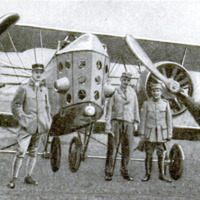Morane-Saulnier Biplane
Item
-
Title (Dublin Core)
-
Morane-Saulnier Biplane
-
Article Title and/or Image Caption (Dublin Core)
-
Portholes in an Airplane Hull. The Engines Are Carried Separately and the Pilot Occupies the Fuselage Alone
-
Caption: A real aero-cruiser with an enclosed cabin to shelter the crew. This new Morane-Saulnier biplane carries two machineguns and three passengers. Note that the engines are carried not in fuselage or body, as usual, but are independent of it. The fuselage itself is provided with portholes to admit light and to permit observation. The two funnels are used for taking photographs
-
extracted text (Extract Text)
-
EARLY in the war high-powered,
weight-carrying airplanes appeared
which were driven by two engines.
But the engines were not housed in the
fuselage or body in which the pilot sits,
but were actually separated from it.
The system has since been improved, as
the accompanying photograph shows.
As soon as the engines are taken out of
thc central fuselage or body, new pos-
sibilities begin to appear. The designer
has full liberty to shape his fuselage as
he pleases. Since it no longer need house
machinery, it becomes a regular ship’s
cabin with portholes.
In the accompanying photograph of the
three-seated French two-engine biplane
which has been designed by Morane-
Saulnier works, the last stage in this de-
velopment is presented. The plane itself
is of rather average size, and yet it is
driven by two light but high-powered
rotary engines. It must be a speedy ma-
chine because of its sheer power and
lightness. When the engines are taken
out of the central fuselage and mounted
between the planes at either side of that
fuselage, there is always a saving in
structural weight. In the interest of high
speed, the fuselage is made deep enough
to enclose the three passengers completely
so that they are well sheltered from the
icy blast that accompanies fast flying at
high altitudes.
But how are the men to see? Ob-
viously by portholes. And so we find
that the walls of the fuselage are pierced
with some fourteen portholes covered with
artificial mica (cellon).
Two of these portholes are set in curious
short funnels projecting from either side.
Obviously they are intended to give a
lateral view. But the funnels, useless to
an observer, serve to house a long-focus
camera and to protect it from the wind.
Thus it becomes possible to take photo-
graphs in any direction.
Most of the portholes are used to throw
light into the fuselage; only the upper
ones are needed for observation.
Of course such machines as these could
not be used for fighting purposes as
they are too unwieldy and too slow of
handling.
-
Language (Dublin Core)
-
eng
-
Date Issued (Dublin Core)
-
1918-05
-
pages (Bibliographic Ontology)
-
666
-
Rights (Dublin Core)
-
Public Domain (Google digitized)
-
Archived by (Dublin Core)
-
Filippo Valle
-
Alberto Bordignon (Supervisor)
 Popular Science Monthly, v. 92, n. 5, 1918
Popular Science Monthly, v. 92, n. 5, 1918



